Glazing options for loggias and tips for choosing

The loggia is an example of a modern design solution created specifically for the comfort of the inhabitants of the apartment. In the city, it replaces the village terrace, being an analogue of the balcony, which at the same time is not so cold, since it is recessed into the outer wall. At the same time, one wall still goes directly to the street, a huge window is located in its entire width, so the owners should think about how not to lose their own home in the thermal insulation. Fortunately, modern materials allow you to successfully cope with this task, you just need to figure out what and how.
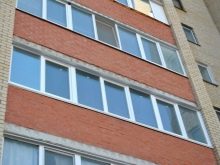
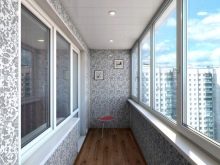
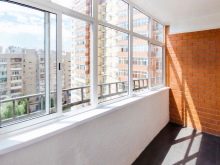
Features and requirements
Loggias in our country are popular if only because their alternative - an ordinary balcony - in the climatic conditions of even central Russia for a significant part of the year is a completely useless area that can hardly be used in any way. The loggia recessed into the thickness of the building is already slightly better protected from the harsh conditions of the street, but still, even it is the weakest point in the thermal insulation of housing. The issue is solved by the glazing of the loggia. In a high-quality performance, it is obliged to solve a number of problems.
- Turn the loggia into a full-fledged room. The fact that there is a large panoramic window here should not create inconvenience to residents - they should be able to arrange furniture here, store any things and certainly not dress specially to go out here.
To comply with all these conditions, it is necessary that the loggia be protected from precipitation, wind and dust, not to mention temperature drops outside the window.


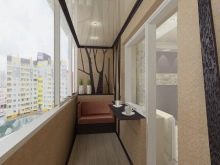
- Protect from noise. Located in the center of a large city, an apartment with a loggia is subject to constant sound load, and this is probably not about birdsong. The sight of city traffic may not bother you, and from the upper floors a pleasant cityscape could open up at all, but sometimes you want silence, which is completely deprived by numerous transport.
Glazing must be able to solve this problem, but if you want a picture with sound - just open the window.
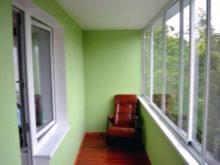
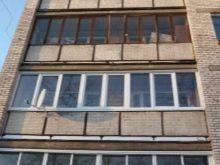
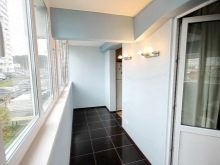
- Allow the creation of a greenhouse. Not every owner equips his own loggia for a flower garden, but glazing can be considered good if it leaves such an opportunity. A high-quality double-glazed window reliably insulates from the cold, even near it, heat-loving plants will not feel that there is a crackling frost outside the window, while it lets in sunlight, which is so necessary for photosynthesis, almost without loss.
Even if today you do not grow anything, the glazing should be chosen taking into account this possibility - later you will want either a piece of summer in winter, or your own small garden.
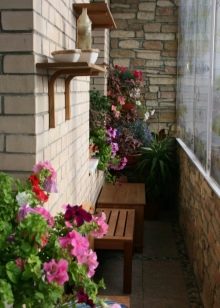
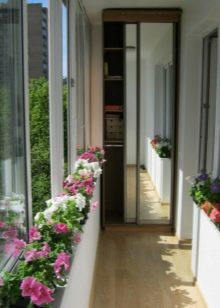
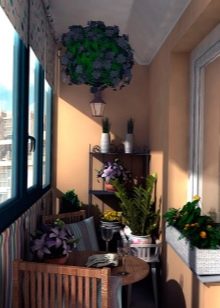
- Additionally, protect the apartment from unauthorized entry. The intruders, of course, will not be stopped by any double-glazed unit - if they set out to penetrate your home, they will knock out the glass and end up inside. But any thief is guided by the maximum silence of his actions, and knocking out a window from two or even three glasses a priori is never quiet, and even threatens with an abundance of sharp fragments.
If the alien does not aim at a specific dwelling, but simply penetrates where there will be no problems with this, a good double-glazed window may be sufficient protection against intrusion.
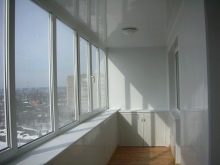
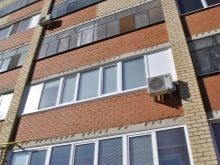
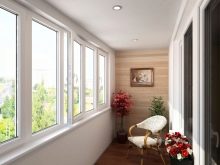
- Be easy to maintain. The degree of transmission of sunlight through a glass unit strongly depends on the degree of purity of the glass. A loggia in which absolutely all windows would open is rare, so it is advisable to think over the design so that from the inside you can reach any corner of the outer side of the windows.
In addition, the frames themselves require periodic cleaning and maintenance, so it is advisable to focus on those materials that are extremely easy to maintain.
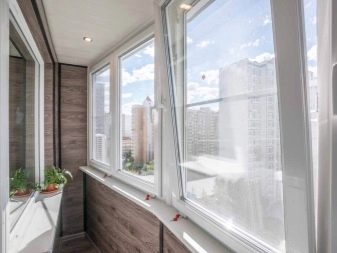
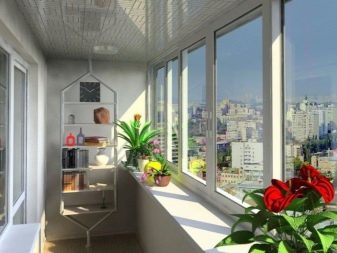
- Be affordable. This is another criterion that should not be listed first, but at the same time it cannot be ignored. Modern materials allow the production of inexpensive, but high-quality and easy-to-maintain double-glazed windows.


Possible ways
There are many options for classifying glazing, but the first thing to decide is whether your glazing will be cold or warm.
Cold
The name of this method speaks for itself - such glazing does not imply an increase in thermal insulation (although in fact it, of course, is still observed to some extent). When installing double-glazed windows, the main emphasis is on protecting the loggia from other negative manifestations of an open street - precipitation, wind, dust, and so on.
Profile material can be any - both wooden and aluminum, at the same time, many owners make frames even on their own - literally from what is at hand. It would seem that the lack of thermal insulation negates any prospects for this type of glazing, but no - even such double-glazed windows are in great demand.
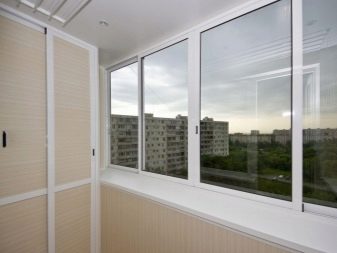
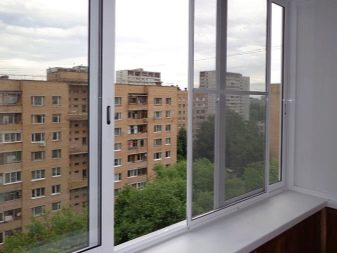
In fact, this is not surprising - if you look closely, the cold method has enough advantages that can lure the consumer, namely:
- the utmost ease of installation is limited by the installation of double-glazed windows and minimal finishing; in many cases, this can be done even independently;
- a cold glass unit itself is relatively inexpensive, and if you also mount it yourself, the savings are impressive;
- cold glazing weighs relatively little, so it does not create unnecessary load on the parapet - in old apartment buildings, where the installation of double-glazed windows was not initially provided for, this can play a key role;
- glass and with cold glazing transmits light well, which means that a brightly shining sun can contribute to a certain increase in temperature in the room;
- a loggia, glazed even with cold glazing, still has a more presentable appearance than an unglazed one.
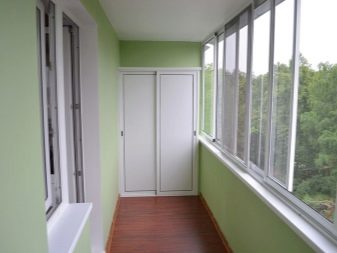
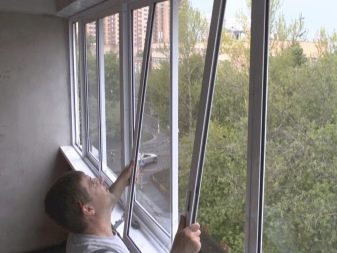
At the same time, there are only two disadvantages, but they are worth paying attention to, perhaps they will turn out to be fundamental and force you to abandon this option. The first has already been said - in the cold season, such windows will practically not give anything in terms of heat saving, you will go out to the loggia just like on the street. In addition, there are such types of frames that do not imply the convenient installation of mosquito nets, and in this case, the comfort of household members will greatly decrease.
However, if the loggia is perceived as just an additional storage room, then such glazing should be enough for you.
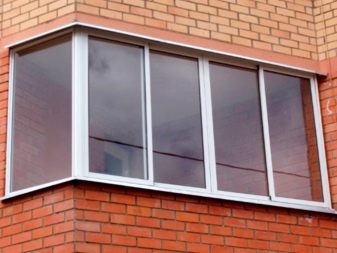

Warm
If, in the case of balconies, both cold and warm glazing have approximately equal validity, then for apartments with loggias it is usually much more expedient to choose the warm glazing option. The fact is that The loggia, being recessed into the outer wall, is inevitably considered an integral part of the apartment, and the exit to it is often equipped with relatively slightly insulated doors, and the quality of the window with access to the loggia is often in doubt. The main contour of thermal insulation is already carried out to the outer wall of the loggia, which means that it needs warm glazing.
Having chosen this approach to the improvement of the apartment, you can use the loggia as an additional room, and this has its advantages. Now it can be a great location for a year-round greenhouse to cheer up in the cold, or a nice seating area if you're lucky enough to have a view from the window. In addition, some owners decide on redevelopment and, in fact, completely abandon a separate loggia, demolishing the partition and connecting it with the room inside the building.
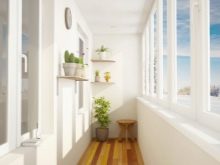
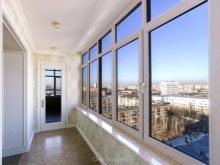

Of course, windows alone are unlikely to be enough for full-fledged insulation of the loggia, because central heating radiators are not taken out here. To solve the problem, they use the installation of underfloor heating systems, while the double-glazed windows themselves should also not be the simplest and cheapest - only multi-chamber PVC options, wooden frames and aluminum structures with a thermal break are suitable. Using this option will cost the owners a tidy sum, but nevertheless, the advantages of warm glazing are so significant that many owners are not afraid to spend money in order to achieve a better result.
Having lost money, a person in return receives the following benefits:
- it is not for nothing that this method of glazing is called warm - by itself it does not solve the problem of thermal insulation, but now it is definitely not the window that will be the least protected place, and when using additional insulation of the walls and floor, the loggia can be turned into a full-fledged part of the apartment;
- for all its soundproofing capabilities, cold glazing is not even close to warm - households will be reliably isolated from any extraneous sounds from the street;
- manufacturers of double-glazed windows for warm glazing care not only about high-quality insulation from the effects of the street, but also about the attractive appearance of their products, thanks to this, the renovated loggia will have a representative appearance and delight the owner with its beauty;
- warm glazing is always more solid than cold, for the same reason it stops potential intruders even more than cold glazing.
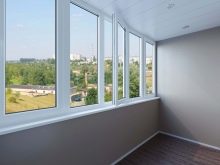


Alas, there are no such solutions in repair and design that would be unambiguously perceived as positive - they are criticized and loggias with warm glazing, namely:
- such a solution will cost much more, so someone will generally refuse such glazing, while someone will have to work hard and limit themselves in some way in order to afford such a repair;
- a loggia glazed in a warm way will no longer be a full-fledged open space, and connoisseurs of fresh air can criticize it for turning into an ordinary room;
- a warm frame, due to insulating materials, weighs much more, so its installation looks advisable only if there is a strong and reliable frame.
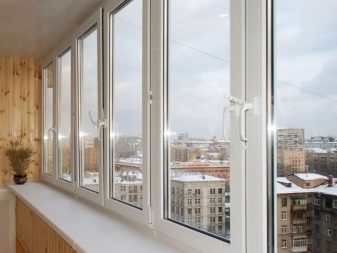
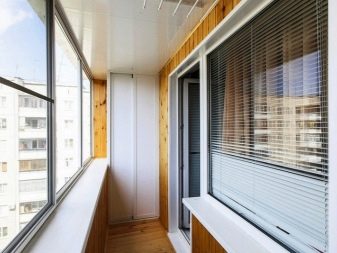
Popular types
One of the most common classifications of glazing for loggias is the division according to the material from which the frames are made. Each popular material has its own advantages and disadvantages.
- Plastic glazing, whose profiles are made of PVC, is nowadays considered the most popular. In combination with double-glazed windows, reliable heat and sound insulation is obtained, while the product looks beautiful, is durable and is relatively inexpensive. By the way of opening, the sash can be either swing or sliding.
There are much fewer minuses, but they also exist: the whole structure weighs quite a lot, and when closed, such a window does not "breathe" at all.
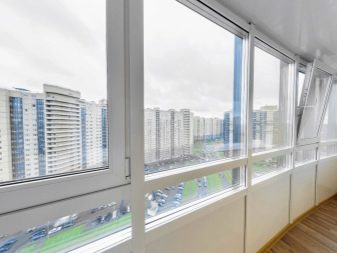
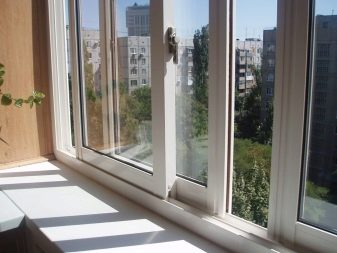
- Wooden frames two decades ago, they were a massive and practically uncontested phenomenon, but then they gave way to more practical plastic. However, no one would completely abandon the tree, especially since recently it has been many times improved to extend its service life. The material, even despite numerous protective impregnations, still remains natural and has the ability to "breathe", confidently provides thermal insulation, weighs a little, while looking very stylish and because of this it is considered elite.
At the same time, a double-glazed window made of wood is very expensive, and without regular renewal of varnish and repeated impregnations, the frame can quickly dry out, crack, burn out in the sun or even rot.
In addition, wooden glazing is almost always done only with swing panels.
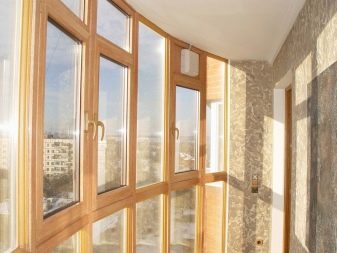

- Aluminum frames began to be used relatively recently, although it is even strange how this idea did not occur to people earlier. The durability of aluminum is striking, in this sense, the frame made of it is optimal, especially since aluminum is very light and durable, looks beautiful, environmentally friendly and is not afraid of any external influences, and it is also inexpensive. On the basis of aluminum frames, you can create both cold and warm glazing, while there are practically no restrictions on the area of the window, and the structure is of the sliding type, so it does not take up much space.
There are few minuses, but, alas, they are also here: only a cold aluminum frame is inexpensive, while a warm system with a thermal break will cost much more, and in terms of sound insulation, aluminum glazing is much inferior to its competitors.
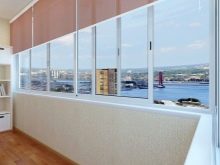
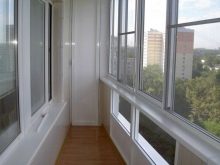

By the way, it is illogical to classify the glazing of loggias only by the material of the frame, if only because there is also a frameless solution. There is no frame as such - the glass component is attached to special guides from above and below, due to which the window is huge and lets in a sea of light. The glass, of course, is used only tempered and thick (from 6 mm), but it can be completely folded to provide maximum access to the street.
This solution is often chosen for its originality, but it has more than enough disadvantages: forget about insulation from cold and noise, do not rely on tightness or the subsequent installation of insulation and mosquito nets. In addition, you will have to forget about privacy too - frameless glazing allows anyone to see what is happening on the loggia from the street.
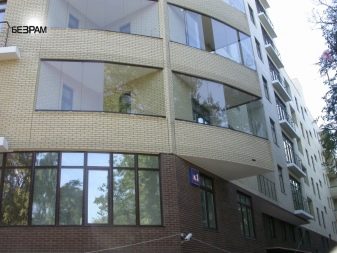
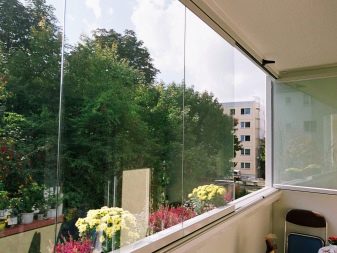
A separate type of glazing can be considered panoramic, which is also called stained glass or French, apparently, according to the country of origin. Such glazing can be warm, cold or frameless, any profile materials are used, the main difference from all other types is that the view opens from floor to ceiling, that is, there is no parapet under the window at all.
Of the advantages, they usually indicate a maximum of natural light in the room and a visual expansion of the space, stylish design and the absence of the need to deal with any decoration - in fact, there are no walls. Of the minuses - intense heat in the summer, caused by the complete absence of shade, lack of privacy for the same reason, difficulty in washing the outside of the glass on your own. Don't forget about the high cost of materials and installation.
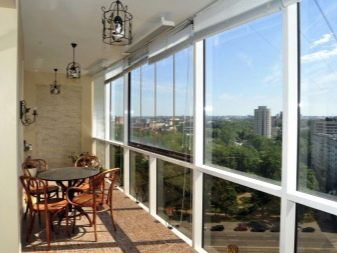

How to choose?
Before choosing windows for glazing a loggia, you need to clearly imagine what result should be obtained in the end and what you are trying to achieve by replacing windows. It is worth starting, of course, with an answer to the question of whether warm or cold glazing suits you more. With a warm one, everything is clear - it actually turns your loggia into another room, and in most apartments this particular option seems more adequate - since the space is drowned in the thickness of the building, let it be a full-fledged room.
Having decided to save money thanks to the choice in favor of cold glazing, the owner actually formalizes his refusal to use the space as a room in the winter, Considering that it is better to glaze the loggia on the cheap, he admits that he considers it just a large pantry, where the temperature does not matter in principle.
Look at the financial component last - there is no point in spending, albeit insignificantly, on cold glazing if it does not provide the use of the loggia for which the repair was started. In addition, you need to decide on the choice of frame material, and here you will have to look at very, very many circumstances. Fortunately, the modern approach to production allows you to get out of any situation, but you need to correctly assess the conditions on your own loggia and give preference to what fits here perfectly.
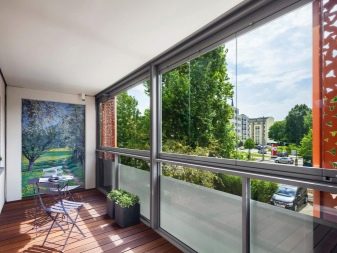
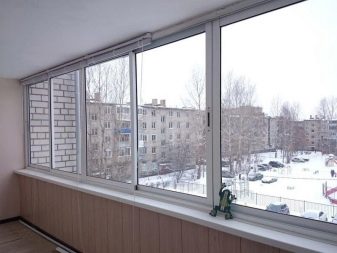
It is worth starting from what, in general, your loggia is capable of.... If it is a completely reliable structure that can support a significant weight, then you can freely experiment with all types of glazing and any possible materials, creating your own design ideal. If the parapet under the future window is unreliable, you no longer have such freedom of choice - you need to take into account the structure's ability to withstand the load.
This is especially true for loggias with an extension - the welded frame does not have a direct support under it, therefore it is highly desirable to install only the lightest glazing options on top of it, for example, frameless or aluminum.

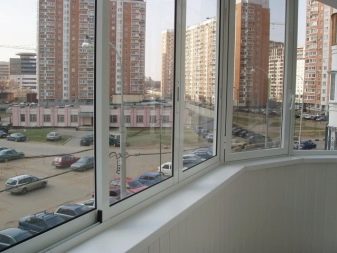
Another important point is protection against street noise.... If the loggia overlooks a quiet courtyard somewhere on the outskirts of the city, only children, whom the owners love very much, can make noise in it - this is one thing, in which case you can not go too much. Another thing is when we are talking about a front window that opens directly onto a busy transport artery, and even is not too high - just within the reach of everyday noise.
In such conditions, there can be no question of proper comfort, therefore it makes sense to install soundproof double-glazed windows, which are best combined with a plastic or aluminum frame.
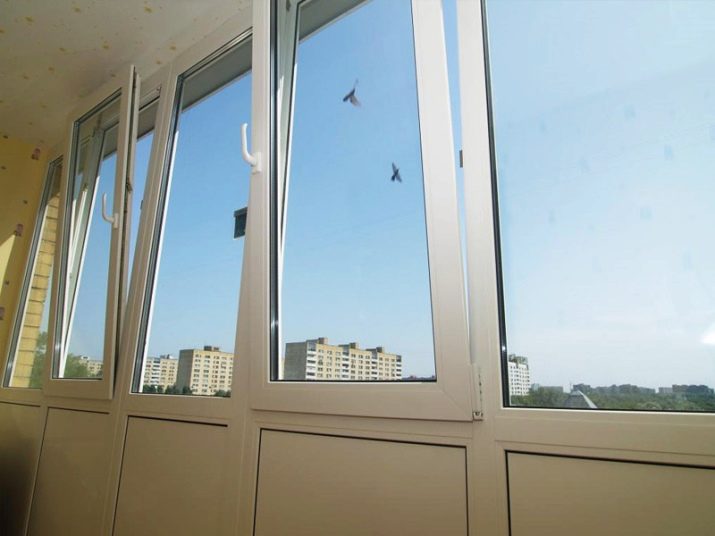
The glazing of the loggia is usually done in order to make the life of the owners easier and more pleasant., but not at all in order to create an additional problem for yourself in terms of regular maintenance of a large window.In terms of cleaning, all the frames are about the same, but for the worse, wooden windows should be highlighted: unfortunately, this material in a completely natural form is subject to too many options for external influences.
Manufacturers, of course, try to protect it with various impregnations and a thick layer of varnish, but all these protections wear out rather quickly, and the owner's task is to constantly update the varnish layer and impregnations.
Ignoring this requirement, the owner runs the risk of disappointment in the wood much earlier than expected, and with proper care, it, on the contrary, will impress with its durability, but the scale of regular maintenance can be an unpleasant surprise.
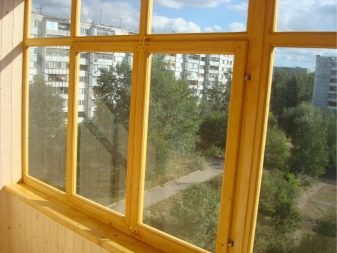

A separate moment is glass washing. With dirty glass, the loggia, even the most stylish and beautiful, will quickly lose its attractiveness, and it will not let light through, then there is no point in it anymore. In the meantime, it is difficult to get to the farthest sections of the glass from the outside and you need to think about how to do it. In this regard, frameless glazing seems to be the most productive solution - the window can be completely folded, which means that there will be no problems with access to both sides of the glass.
Swing sashes also seem to be a pretty convenient solution, But panoramic glazing can become a real problem - when you need to wash an entire wall outside, it is possible that you simply cannot do without outside help.
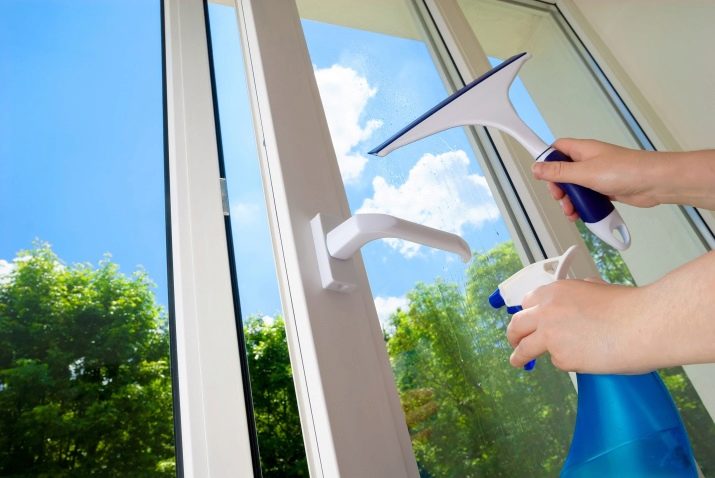
Another fundamental point that is too often forgotten is this is the degree of privacy provided by the glazing of the loggia. Recently, many owners, chasing fashion, mount either frameless or even panoramic windows, focusing on good lighting and a fresh approach to interior design.
An unpleasant surprise for them is that now they are practically defenseless in front of views from the street, and if the loggia is a direct continuation of the room, then even in the depths of the room they cannot hide from the curious. While it is a bright day outside, you can still hide in the twilight, moving away from the window, but in the evening, with the inclusion of internal electric lighting, households will live as if in a shop window.
In addition, the above-described frameless and panoramic windows can carry another serious problem that significantly affects comfort: the fact is that they are completely unsuitable for installing mosquito nets. At the same time, even in the northern regions of our country, characterized by a cool climate, a huge amount of midges is bred in the summer, and even in warmer regions, through a "gap in the defense", whole hordes of insects will be trampled into the apartment.
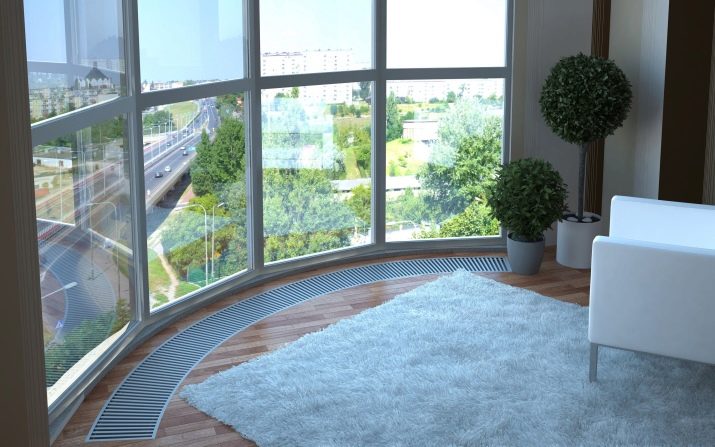
It is worth paying attention to the design, but not a single manufacturer, of course, focuses on the production of ugly windows - the only question is what seems more attractive to the buyer and will fit better into his apartment. In terms of the apparent high cost and aristocracy, wood is especially prominent - it does not even need to be painted, it is perceived as an element of luxury even in natural color.
Plastic and aluminum look good in modern and futuristic designs, especially since both options allow for a variety of colors and shades. French glazing is a priori associated with the Provence style and slightly resembles a rustic style in the best sense of the word. Frameless windows, like plastic with aluminum, look like an attribute of the future.
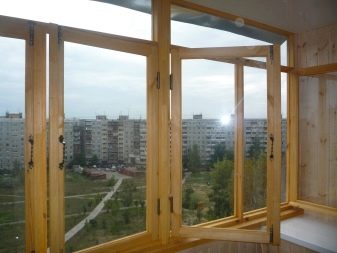
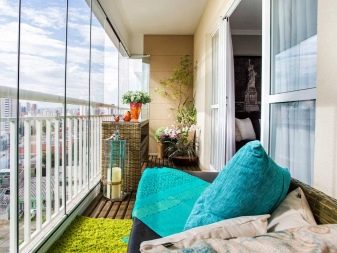
Specialist recommendations
Many homeowners, when choosing glazing options for a loggia, lack the knowledge of professionals who could suggest something interesting based on their own personal experience. We've put together a few sensible guidelines that the reader might find useful.
- The choice between cold and warm glazing in the case of a loggia almost never rises - the vast majority of consumers choose the warm option.Cold glazing may still be appropriate for a balcony separated from the apartment by a main wall and requiring double-glazed windows on three sides, but the loggia is already recessed into the building. It turns out that a warm double-glazed window in one wall will be needed in any case, simply by installing it on the border of the loggia and the room, the owner deliberately refuses a piece of his own apartment. Such a step is only appropriate if a large "refrigerator" is needed for some reason in winter, otherwise it is difficult to explain such a decision.
- It is necessary to choose warm double-glazed windows, but it would be naive to believe that they themselves will make the loggia really warm. The wind will no longer blow here, and the bitter frosts will not cool the room so quickly, but dwellings become really warm not so much due to tightness as due to heating. On the loggia, it is not by default, so the owner must think over the installation of a system of underfloor heating - this is the most reasonable option, since centralized heating may require many permits. Without heating, even the highest quality double-glazed windows will not save the loggia from the coolness, especially in thirty-degree frosts.
- It is necessary to focus on the fact that many consumers unreasonably chase only design, completely forgetting that glazing a loggia is a practical task... When deciding which glazing option to choose, do not immediately think about how it will look - think over what useful criteria the glazed loggia should meet, and choose only among those windows that allow you to solve these problems. Only this approach will leave a holistic positive impression from the repair of the loggia and provide complete comfort.
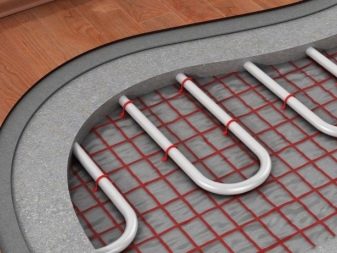
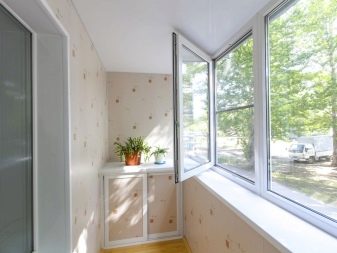
For more information on the options for glazing and finishing loggias, see the next video.








